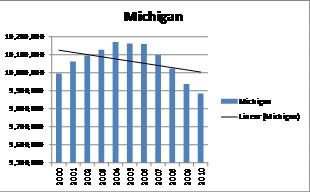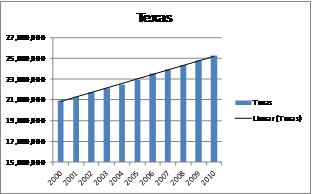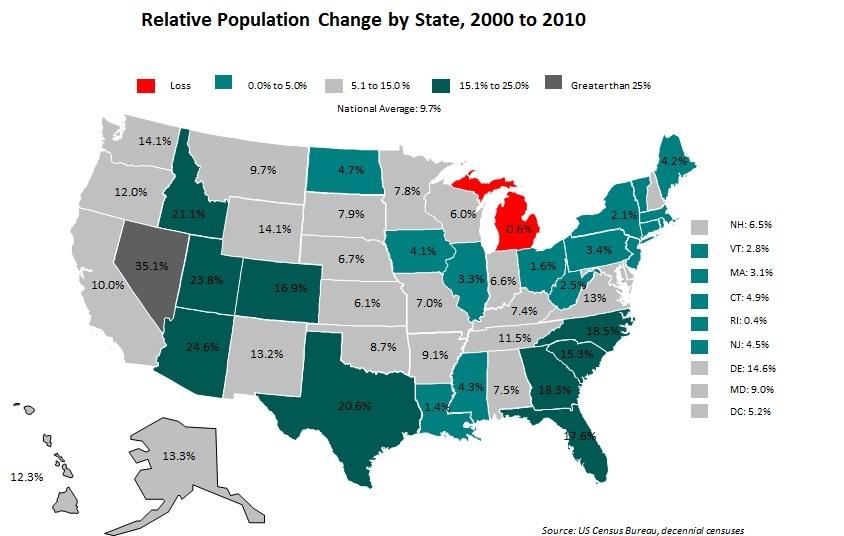This article was written by Jonathan Tyroch of VMG Health.
Consider two identical ambulatory surgery centers – one located in Texas and one in Michigan. Assuming that all historical operating characteristics of the two centers are the same – revenue, EBITDA, case mix, physician mix & age, payor mix – would the ASCs have equal or different values? Without understanding the demographic conditions and trends in the local and regional marketplaces a valuation analyst would believe the centers have to be of equal value. However, as the valuation analyst delves deeper into the demographic makeup of each location, population trends quickly become a stark point of contrast for these two locales.


As illustrated in the graphs above, since 2000 Texas has experienced robust population growth (up 20.5% overall, or 1.9% compounded annually) while Michigan has experienced a population decline during that same time period (-1.1% overall, or -0.1% compounded annually). Within each state there are more specific areas that have seen population growth/decline at even larger levels of disparity. Frisco, Texas has grown 247.5% since 2000 while Detroit, Michigan has lost approximately 25.0% of its population. When formulating valuation assumptions for the two ASC’s, shouldn’t these trends be considered? Without strong supporting data, validating and utilizing similar volume assumptions for the two centers in question would be extremely difficult given the historical population trends of the local areas. Thus, the values of these ASCs could be drastically different.

Population trends have varied drastically across the country throughout the last 10 years as shown in the map above. Along with population growth trends, there are other important marketplace and population characteristics for the valuation analyst to understand including gender mix, race mix, income levels and age mix. From the impact of disease incidence rates (on each of these population sets) as well potential shifts in payor mixes due to healthcare reform, an analyst must have a handle on characteristics that may be thought to be ‘outside’ or of little impact to the business, that in reality have a direct influence on the current operations and go forward assumptions. Along with operational specifics, these demographic factors in the aggregate will help to form the foundation and be the basis of support for the analyst’s projections. The next time valuation assumptions are being formulated the analyst must not forget to look deeper into the businesses operational characteristics to see if there are demographic factors at play.
Consider two identical ambulatory surgery centers – one located in Texas and one in Michigan. Assuming that all historical operating characteristics of the two centers are the same – revenue, EBITDA, case mix, physician mix & age, payor mix – would the ASCs have equal or different values? Without understanding the demographic conditions and trends in the local and regional marketplaces a valuation analyst would believe the centers have to be of equal value. However, as the valuation analyst delves deeper into the demographic makeup of each location, population trends quickly become a stark point of contrast for these two locales.


As illustrated in the graphs above, since 2000 Texas has experienced robust population growth (up 20.5% overall, or 1.9% compounded annually) while Michigan has experienced a population decline during that same time period (-1.1% overall, or -0.1% compounded annually). Within each state there are more specific areas that have seen population growth/decline at even larger levels of disparity. Frisco, Texas has grown 247.5% since 2000 while Detroit, Michigan has lost approximately 25.0% of its population. When formulating valuation assumptions for the two ASC’s, shouldn’t these trends be considered? Without strong supporting data, validating and utilizing similar volume assumptions for the two centers in question would be extremely difficult given the historical population trends of the local areas. Thus, the values of these ASCs could be drastically different.

Population trends have varied drastically across the country throughout the last 10 years as shown in the map above. Along with population growth trends, there are other important marketplace and population characteristics for the valuation analyst to understand including gender mix, race mix, income levels and age mix. From the impact of disease incidence rates (on each of these population sets) as well potential shifts in payor mixes due to healthcare reform, an analyst must have a handle on characteristics that may be thought to be ‘outside’ or of little impact to the business, that in reality have a direct influence on the current operations and go forward assumptions. Along with operational specifics, these demographic factors in the aggregate will help to form the foundation and be the basis of support for the analyst’s projections. The next time valuation assumptions are being formulated the analyst must not forget to look deeper into the businesses operational characteristics to see if there are demographic factors at play.

